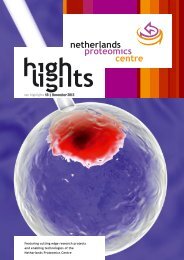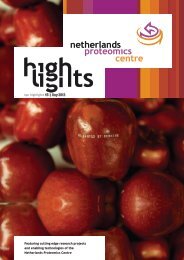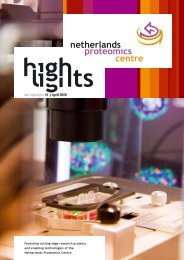NPC Valorisation Voucher - Netherlands Proteomics Centre
NPC Valorisation Voucher - Netherlands Proteomics Centre
NPC Valorisation Voucher - Netherlands Proteomics Centre
You also want an ePaper? Increase the reach of your titles
YUMPU automatically turns print PDFs into web optimized ePapers that Google loves.
separation step (see Figure 3c). In addition, only 101 peptides(corresponding to approximately 0.6% of the total of 15,775peptides) found in the 1D analysis were not identified in the2D experiment, which potentially may be attributed to theincompatibility of certain peptides with the HILIC solvents. Ingeneral, both Venn diagrams (see Figure 3b and 3c) showedlarge overlaps, suggesting that the peptides identified in the1D RP analysis are merely higher abundant peptides that areall also detected in the ZIC-cHILIC-RP strategy.A further comparison between the obtained proteome dataand previous microarray experiments from the same colonstem cells confirmed the quality of our method, showing that95% of the proteins detected in this study were also foundto be expressed at the mRNA level. Furthermore, 21% of theGFP+ colon stem cell specific genes could be detected in ourproteomics screen, and two of the identified proteins, CD44and EphB3, have been reported to be expressed highest at thebottom of the crypt, where the colon stem cells reside.A Gene Ontology analysis for molecular function and biologicalprocesses of the 3,775 detected proteins revealed that the 2Dstrategy covered all the most important functional categories,including, for instance, proteins involved in transcriptionmechanisms, in receptor activity and in translation regulationactivity.Major step forward Notwithstanding the huge advancesmade in proteomics in the last decade, sensitive technologiesare still needed to access proteome-wide data for a limitednumber of cells, for instance originating from laser microdissections,flow cytometry, tumour biopsy and other scenarioswhere sample material will be a limiting factor. We demonstratedthat the 2D HILIC based strategy developed in ourlaboratory leads to a significant reduction of sample complexitywith nearly negligible sample loss. The approach describedhere represents a major step forward towards a more sensitiveproteome analysis. We propose to introduce ZIC-cHILIC as afractionation method in shotgun proteomics strategy for theanalysis of only a few thousands of cells. [7] Furthermore, thisstrategy, in combination with metabolic or chemical labellingbased quantification [8], can investigate and compare withhigh-sensitivity specific cell proteomes.References1 Altelaar A.F.M. et al. (2012) Trends in ultrasensitive proteomics.Current Opinion in Chemical Biology 16, 206-213.2 Di Palma S. et al. (2012) Recent advances in peptideseparation by multidimensional liquid chromatography forproteome analysis. Journal of <strong>Proteomics</strong> 75, 3791-3813.3 Boersema P.J. et al. (2007) Evaluation and optimization ofZIC-HILIC-RP as an alternative MudPIT strategy. Journal ofProteome Research 6, 937-946.4 Boersema P.J. et al. (2008) Hydrophilic interaction liquidchromatography (HILIC) in proteomics. Anal Bioanal Chem391, 151-159.5 Di Palma S. et al. (2011) Zwitterionic hydrophilic interactionliquid chromatography (ZIC-HILIC and ZIC-cHILIC)provide high resolution separation and increase sensitivityin proteome analysis. Anal Chem 83, 3440-3447.6 Di Palma S. et al. (2011) Highly sensitive proteome analysisof FACS-sorted adult colon stem cells. J Proteome Res 10,3814-3819.7 Di Palma S. et al. (2012) ZIC-cHILIC as a fractionationmethod for sensitive and powerful shotgun proteomics. NatProtocols 7, 2041–2055.8 Di Palma S. et al. (2011) Evaluation of the deuteriumisotope effect in zwitterionic hydrophilic interaction liquidchromatography separations for implementation in a quantitativeproteomic approach. Anal Chem 83, 8352-8356.ContactSerena Di Palma, MScBiomolecular Mass Spectrometry and <strong>Proteomics</strong> GroupUtrecht UniversityPadualaan 83584 CH Utrecht, The <strong>Netherlands</strong>T +31 30 253 3664S.DiPalma@uu.nl| 19summaryIn proteomics, multidimensional liquid chromatographycombined with mass spectrometry has become a standardtechnique to reduce sample complexity and tackle the vastdynamic range. Such fractionation is necessary to obtaina comprehensive analysis of biological samples such astissues and cell lines. However, extensive fractionationcomes at the expense of sample loss, hampering the analysisof limited material. Here we describe a highly sensitivetwo-dimensional chromatographic strategy based on acombination of hydrophilic interaction liquid chromatography(with a zwitterionic stationary phase) and reversed-phasechromatography. This strategy allows shotgun proteomicsanalysis with minimal sample loss. We applied this technologyto the analysis of a limited number of FACS-sorted colon stemcells extracted from mouse intestine, obtaining proteomecoverage comparable to current methods that generallyrequire 100-fold more starting material. We propose that thisalternative multidimensional chromatographic technology willfind ample application in biomedical and biological research,such as in the analysis of distinct cellular populations obtainedby laser microdissection or flow cytometry.






